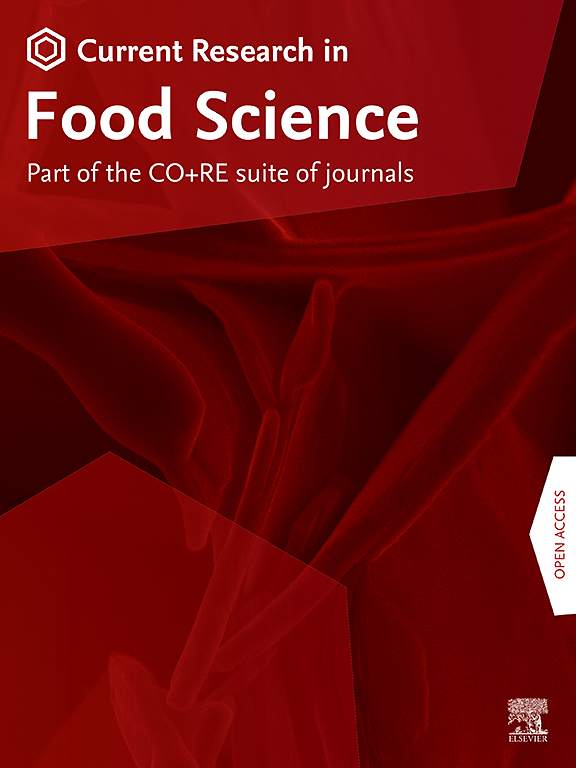Lacticaseibacillus casei IDCC 3451 alleviates cognitive and behavioral functions by reshaping the gut microbiome and regulating intestinal barrier integrity in chronic stress animal models
IF 6.2
2区 农林科学
Q1 FOOD SCIENCE & TECHNOLOGY
引用次数: 0
Abstract
Lacticaseibacillus casei IDCC 3451 (3451) was evaluated for its effects on the gut-brain axis using Caenorhabditis elegans (C. elegans) and mouse models of stress and inflammation. In C. elegans, 3451 extended lifespans by 25 %, improved motility, and chemotaxis, enhanced survival under pathogen challenge, and reduced amyloid beta accumulation by 42 %. Transcriptomic profiling revealed upregulation of genes involved in neurotransmitter signaling and serine/threonine pathways. In the unpredictable chronic mild stress (UCMS) mouse model, 3451 administration increased the time spent in the center of the open field by 65 % and reduced immobility in the forced swim test by 32 %, indicating anxiolytic and antidepressant effects. Serum levels of aspartate aminotransferase (AST) and gamma-glutamyl transferase (GGT) were decreased by 18 % and 24 %, respectively. Additionally, 3451 restored the expressions of 5HT1AR, GABAR, and tight junction proteins, including ZO-1 and Claudin1. Metabolomic analysis showed increased glycine and decreased palmitic acid levels, associated with an increased abundance of Ruminococcus and Akkermansia. In the dextran sulfate sodium (DSS)-induced colitis model, 3451 reduced the disease activity index by 36 %, improved colon histology, increased goblet cell preservation, and upregulated ZO-1 and IL-10 expression. Threonine levels were also increased and correlated with a higher abundance of Coprococcus. These findings demonstrate that 3451 improved behavioral and intestinal outcomes through coordinated modulation of host signaling, metabolite production, and gut microbial composition, highlighting its therapeutic potential for managing IBD and neurobehavioral disorders.

在慢性应激动物模型中,干酪乳杆菌IDCC 3451通过重塑肠道微生物群和调节肠道屏障完整性来缓解认知和行为功能
利用秀丽隐杆线虫(C. elegans)和小鼠应激和炎症模型,评估了干酪乳杆菌IDCC 3451(3451)对肠-脑轴的影响。在秀丽隐杆线虫中,3451延长了25%的寿命,改善了活动性和趋化性,提高了病原体挑战下的存活率,并减少了42%的淀粉样蛋白积累。转录组学分析显示参与神经递质信号和丝氨酸/苏氨酸途径的基因上调。在不可预测的慢性轻度应激(UCMS)小鼠模型中,给药3451使开放场地中心的停留时间增加65%,使强迫游泳试验中的不动时间减少32%,显示出抗焦虑和抗抑郁作用。血清天冬氨酸转氨酶(AST)和γ -谷氨酰转移酶(GGT)水平分别下降18%和24%。此外,3451恢复了5HT1AR、GABAR和紧密连接蛋白(包括ZO-1和Claudin1)的表达。代谢组学分析显示甘氨酸水平升高,棕榈酸水平降低,与Ruminococcus和Akkermansia丰度增加有关。在葡聚糖硫酸钠(DSS)诱导的结肠炎模型中,3451降低了36%的疾病活性指数,改善了结肠组织学,增加了杯状细胞保存,上调了ZO-1和IL-10的表达。苏氨酸水平也有所增加,并与较高的粪球菌丰度相关。这些发现表明3451通过协调调节宿主信号、代谢物产生和肠道微生物组成来改善行为和肠道结果,突出了其治疗IBD和神经行为障碍的潜力。
本文章由计算机程序翻译,如有差异,请以英文原文为准。
求助全文
约1分钟内获得全文
求助全文
来源期刊

Current Research in Food Science
Agricultural and Biological Sciences-Food Science
CiteScore
7.40
自引率
3.20%
发文量
232
审稿时长
84 days
期刊介绍:
Current Research in Food Science is an international peer-reviewed journal dedicated to advancing the breadth of knowledge in the field of food science. It serves as a platform for publishing original research articles and short communications that encompass a wide array of topics, including food chemistry, physics, microbiology, nutrition, nutraceuticals, process and package engineering, materials science, food sustainability, and food security. By covering these diverse areas, the journal aims to provide a comprehensive source of the latest scientific findings and technological advancements that are shaping the future of the food industry. The journal's scope is designed to address the multidisciplinary nature of food science, reflecting its commitment to promoting innovation and ensuring the safety and quality of the food supply.
 求助内容:
求助内容: 应助结果提醒方式:
应助结果提醒方式:


